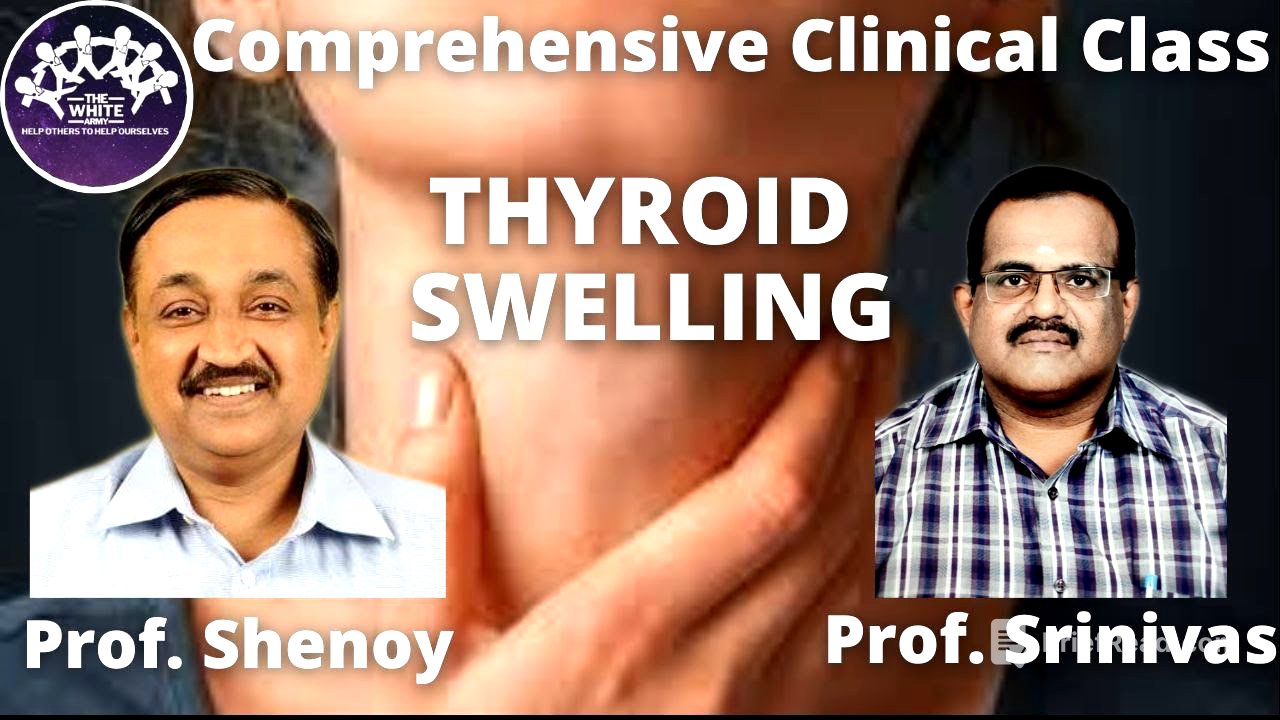TLDR;
This session features a case presentation on a 60-year-old lady with a swelling in the neck, followed by a detailed discussion and guidance from experienced surgeons. The mentors provide valuable insights on history taking, examination techniques, differential diagnosis, and management of thyroid swellings. Key takeaways include the importance of methodical history taking, understanding the anatomical and physiological aspects of thyroid swellings, and considering potential complications.
- Methodical history taking and examination are crucial for accurate diagnosis.
- Understanding the anatomical and physiological aspects of thyroid swellings is essential.
- Surgical management is often preferred for large, non-toxic multi-nodular goiters.
Intro [0:00]
The session begins with an introduction of the mentors, Professor Raj Gopal Shenoy and Professor Srinivasan, who will be guiding the case presentation on a swelling in the neck. Neha presents the case of a 60-year-old lady with a 10-year history of painless swelling in front of her neck.
Patient History [0:40]
Neha presents the patient's history, including her chief complaint of swelling in front of the neck since 10 years. The swelling started small and gradually progressed to its current size. The patient denies any symptoms of hyperthyroidism or hypothyroidism, difficulty in breathing or swallowing, or hoarseness of voice. Her past medical and family history are unremarkable. She consumes iodized salt and doesn't consume much goitrogenic food.
Basic Thyroid Anatomy and Physiology [3:44]
Professor Srinivasan asks Neha about the basics of thyroid anatomy and physiology. Neha explains the structure of the thyroid gland, including the lobes, isthmus, and follicles. She also describes the arterial supply and venous drainage of the thyroid, as well as the important nerves associated with the thyroid, such as the external and recurrent laryngeal nerves. She explains why the thyroid moves up with deglutition due to its attachment to the cricoid cartilage via Berry's ligament.
Presenting Patient History Effectively [6:54]
Professor Shenoy advises Neha on how to present the patient's history more effectively. He suggests providing specific details like age, address, education, and occupation in a clear and concise manner. He emphasizes the importance of using continuous sentences to describe the swelling and presenting the information in a logical order.
Initial Assessment of Swelling [8:29]
Professor Shenoy discusses the initial assessment of a patient presenting with a long-standing swelling. He emphasizes that the first consideration should be whether the swelling is benign, given its presence for 10 years. He then explores the reasons why the patient might have delayed seeking medical attention, such as financial constraints, literacy, or lack of awareness.
Age and Etiology of Thyroid Swellings [10:48]
Professor Shenoy explains the importance of age in determining the possible etiologies of thyroid swellings. He notes that younger patients may be more concerned about cosmetic issues, while older patients may delay seeking treatment. He also discusses the different types of thyroid cancers that are more common at different ages.
Describing Swelling Size and Characteristics [12:10]
Professor Shenoy advises Neha on how to describe the size and characteristics of the swelling. He suggests using relatable comparisons, such as a cricket ball, to describe the size. He also explains the significance of a rapid increase in size, which could indicate hemorrhage or malignant transformation.
Importance of Pain History [14:38]
Professor Shenoy emphasizes that pain is not a typical feature of thyroid swellings. He advises against focusing too much on pain in the initial assessment, as it can lead to unnecessary complications in the diagnosis.
Methodical Approach to History Taking [15:32]
Professor Shenoy stresses the importance of a methodical approach to history taking. He suggests first inquiring about the thyroid gland's progress and any previous treatments. Then, he advises focusing on local compression issues like difficulty in breathing, difficulty in swallowing, and hoarseness of voice.
Compression and Breathing Difficulties [16:41]
Professor Shenoy discusses the causes of breathing difficulties in patients with thyroid swellings. He explains that compression of the tracheal cartilages can lead to pressure entropy and tracheomalacia. He also mentions that hyperthyroidism can cause congestive cardiac failure, leading to dyspnea.
Thyrotoxicosis and Cardiac Involvement [18:31]
Professor Shenoy differentiates between primary and secondary thyrotoxicosis, also known as Plummer's disease. He notes that cardiac involvement is more common in secondary thyrotoxicosis. He also mentions the potential for eye complications, including blindness, in severe cases of primary thyrotoxicosis.
Swallowing Difficulties and Hoarseness [20:08]
Professor Shenoy explains that difficulty in swallowing is usually due to compression of the esophagus by the thyroid swelling. Hoarseness, on the other hand, is caused by irritation of the recurrent laryngeal nerve.
Toxicosis and Hypothyroidism Symptoms [21:43]
Professor Shenoy advises Neha to summarize the absence of toxicosis and hypothyroidism symptoms in one sentence. He suggests asking specific questions about CNS, gastrointestinal, and skeletal symptoms to rule out these conditions.
Looking for Other Swellings [23:57]
Professor Shenoy explains that when inquiring about other swellings, the primary focus should be on other neck nodes. He then discusses the possibility of bony swellings in the skull or sternum, which could indicate follicular carcinoma.
Follicular vs. Papillary Carcinoma [25:20]
Professor Shenoy provides a mnemonic (FBS - Follicular Bone Spread) to help remember that follicular carcinoma commonly spreads to bone. He also notes that follicular carcinoma typically presents with bony swellings, while breast cancer is more likely to cause back pain.
Duration and Type of Toxicosis [26:49]
Professor Shenoy discusses the duration of toxicosis and the types that can develop over time. He notes that primary thyrotoxicosis typically presents with eye symptoms, while secondary thyrotoxicosis is more likely to develop after a long period.
Thyrotoxicosis vs. Hyperthyroidism [27:26]
Professor Shenoy clarifies the difference between thyrotoxicosis and hyperthyroidism. He explains that hyperthyroidism is a type of thyrotoxicosis specifically caused by the thyroid gland producing too much thyroxine.
Malignancy and Jaundice [28:15]
Professor Shenoy advises against mentioning jaundice in the history, as it is rarely associated with thyroid malignancies. He explains that liver metastasis typically does not cause jaundice unless a significant portion of the liver is damaged.
Specific History for Thyroid Swellings [29:48]
Professor Shenoy emphasizes the importance of being specific when taking a history for thyroid swellings. He suggests focusing on neck swellings and bone swellings, and considering lymph node involvement in papillary carcinoma and hematogenous spread in follicular carcinoma.
History of Previous Surgery and Radiation [30:30]
Professor Shenoy discusses the importance of asking about previous surgeries and radiation exposure. He notes that a history of thyroid surgery could indicate recurrent papillary carcinoma, while radiation exposure increases the risk of papillary thyroid cancer.
Sources of Radiation Exposure [31:43]
Professor Shenoy elaborates on potential sources of radiation exposure, including childhood lymphoma treatment, head and neck malignancies, and multiple CT scans.
Long-Term Drug Intake and Goitrogenic Drugs [33:12]
Professor Shenoy discusses the importance of inquiring about long-term drug intake, particularly goitrogenic drugs. He mentions amiodarone and lithium as examples of drugs that can affect the thyroid gland.
Medication History and Thyroid Supplements [35:00]
Professor Shenoy explains how to determine if a patient is taking anti-thyroid drugs or thyroid supplements based on the dosing regimen.
Dietary Habits and Goitrogenic Food [35:57]
Professor Shenoy advises against focusing too much on goitrogenic food consumption, as it is less relevant in modern times. He suggests simply asking about the patient's diet and whether they consume iodized salt.
Insomnia and Thyroid Conditions [36:35]
Professor Shenoy clarifies that insomnia is a more prominent feature of primary thyrotoxicosis, while hypothyroidism is associated with increased sleepiness.
Importance of Family History [37:52]
Professor Shenoy discusses the importance of family history in thyroid conditions. He mentions genetic syndromes like MEN syndrome and Cowden syndrome, as well as familial dyshormonogenesis. He emphasizes the significance of endemic goiter areas within the neighborhood.
Diagnosis at This Stage [39:39]
Professor Shenoy suggests that at this stage, the diagnosis should be goiter in a euthyroid state without any metastatic symptoms. He prefers the term "non-malignant" over "no metastasis" to avoid premature assumptions.
General Physical Examination [40:45]
Neha describes the general physical examination findings, noting that the patient is conscious, well-oriented, and cooperative. She mentions the absence of pallor, icterus, lymphadenopathy, pretibial myxedema, and clubbing.
Relevance of General Examination Findings [41:27]
Professor Shenoy questions the relevance of certain general examination findings in this specific case. He advises against mentioning lymph nodes, pretibial myxedema, and clubbing unless they are directly relevant to the patient's condition.
Pretibial Myxedema and Hypothyroidism [43:38]
Professor Shenoy explains that pretibial myxedema is associated with primary thyrotoxicosis and is characterized by bilateral, symmetrical, non-pitting edema in the pretibial area. He also mentions the ankle jerk test as a way to assess hypothyroidism.
Vital Signs [45:11]
Neha presents the patient's vital signs, including pulse rate, blood pressure, respiration rate, and temperature.
Examination of the Neck [45:29]
Neha describes the examination of the neck, noting a single swelling in the anterior neck in the thyroid region. The swelling moves with deglutition, and the skin appears normal.
Inspection and Prominence of Swelling [47:10]
Professor Shenoy discusses how to make a small swelling more prominent during inspection. He explains that extending the neck can cause cervical lordosis, pushing the thyroid gland anteriorly.
Contraction Against Resistance [48:57]
Professor Shenoy emphasizes the importance of contraction against resistance when examining the sternocleidomastoid muscle.
Describing Swelling Dimensions [49:44]
Professor Shenoy advises Neha to clearly specify the transverse and vertical diameters of the swelling. He also notes that the left lobe appears to be more enlarged than the right lobe.
Swallowing and Berry's Ligament [51:39]
Professor Shenoy suggests providing a glass of water to the patient to facilitate swallowing during the examination. He explains that the thyroid moves with deglutition due to its enclosure in the pre-tracheal fascia and attachment to Berry's ligament.
Restricted Movement of Thyroid [53:00]
Professor Shenoy discusses the conditions in which the thyroid may not move with deglutition, such as large swellings, infiltration by carcinoma, or retrosternal extension.
Skin Over Swelling and Tenderness [54:39]
Professor Shenoy notes that the skin over large goiters may be stretched or shiny. He also explains that tenderness is usually associated with thyroiditis, not typical thyroid swellings.
Palpation Technique [55:58]
Professor Shenoy advises Neha to go behind the patient and gently flex the neck to relax the muscles before palpating the thyroid gland with both hands.
Palpating Lobes and Isthmus [57:30]
Professor Shenoy emphasizes the importance of palpating both lobes and the isthmus of the thyroid gland. He explains how to determine if the isthmus is palpable by feeling for the tracheal cartilages beneath the Adam's apple.
Surface, Borders, and Consistency [59:01]
Professor Shenoy advises Neha to describe the surface, borders, and consistency of the swelling in detail. He notes that the information provided in the next slide should be included here.
Correcting Case Sheet [1:00:06]
Professor Shenoy guides Neha on how to present the examination findings in a correct and organized manner, focusing on temperature, tenderness, size, extent, surface, borders, and skin condition.
Firmness and Cystic Areas [1:01:09]
Professor Shenoy questions Neha about how she determined that some areas of the swelling were cystic. He introduces Paget's test as a way to elicit fluctuation in small swellings.
Paget's Test and Tumor Necrosis [1:01:56]
Professor Shenoy explains that Paget's test involves feeling for softness in the center and firmness at the periphery of the swelling. He notes that this can occur due to tumor necrosis or cystic degeneration in large goiters.
Oscillated Surface and Details [1:03:00]
Professor Shenoy suggests using the term "oscillated surface" for large nodules. He also reminds Neha to specify which lobe is larger and to provide details about the isthmus.
Chin Test and Neck Flexion Test [1:03:28]
Professor Shenoy explains that if a swelling moves with deglutition, there is no need to mention the chin test or neck flexion test.
Trachea Position and Trail Sign [1:03:59]
Professor Shenoy discusses the position of the trachea and the Trail sign. He notes that the trachea may be shifted to the right if the left lobe is larger.
Carotid Pulse and C6 Area [1:05:04]
Professor Shenoy explains that in a large swelling, the carotid pulse may be shifted laterally. He also notes that the C6 area is where the pharynx becomes the esophagus.
Carotid Artery and Upper Body [1:06:19]
Professor Shenoy mentions that the common carotid artery bifurcates into the external and internal carotid arteries at the upper body of the thyroid cartilage.
Lymph Nodes and Lower Border [1:07:09]
Professor Shenoy emphasizes the importance of examining the lymph nodes. He also explains that if the lower border of the swelling is not palpable, it could indicate retrosternal extension.
Types of Retrosternal Goiter [1:07:34]
Professor Shenoy describes the different types of retrosternal goiter, including extending and plunging types.
Ascertaining Brewery [1:08:50]
Professor Shenoy explains that a brewery is heard in the superior pole due to increased vascularity in thyrotoxicosis or certain malignancies.
Superior Thyroid Artery [1:09:22]
Professor Shenoy notes that the superior thyroid artery is more superficial and doesn't branch out like the inferior thyroid artery, making the brewery better heard in the superior pole.
Respiratory, CVS, and Abdomen Examination [1:09:57]
Professor Shenoy mentions the need to examine the respiratory, cardiovascular, and abdomen systems for any compression effects.
Musculoskeletal Examination [1:10:11]
Professor Shenoy discusses the musculoskeletal examination in primary thyrotoxicosis, focusing on pretibial myxedema, proximal optimal myopathy, and thyroid acropachy.
Final Diagnosis [1:10:45]
Neha states the final diagnosis as multi-nodular goiter in a euthyroid state.
Anatomical, Physiological, and Pathological Diagnosis [1:11:01]
Professor Shenoy explains that the diagnosis should include anatomical, physiological, and pathological aspects. He asks why Neha believes it is a thyroid gland and why she diagnosed it as multi-nodular goiter.
Symptoms and Signs of Malignancy [1:13:12]
Professor Shenoy asks about the symptoms and signs that would raise suspicion for malignancy. Neha mentions rapid increase in size and hoarseness of voice. Professor Shenoy adds hard swelling, palpable lymph nodes, and fixity as clinical signs.
Investigations [1:15:02]
Neha lists the investigations she would like to order, including thyroid function tests, USG, USG-guided FNAC, and X-ray neck.
Aim of Investigations [1:15:28]
Professor Shenoy explains that the aim of investigations is to confirm the diagnosis, assess physiological function, rule out malignancy, and assess general fitness.
Flexible Laryngoscope [1:16:01]
Professor Shenoy discusses the role of flexible laryngoscopy for medical-legal purposes, as well as to assess vocal cord function.
Ultrasound Guided FNAC [1:17:06]
Professor Shenoy asks why Neha wants to do ultrasound-guided FNAC and which nodule she would like to sample. Neha explains that it is important to sample a solid swelling and not a cystic area.
FNAC Criteria and Trucut Biopsy [1:19:02]
Professor Shenoy asks about FNAC criteria and the role of trucut biopsy. He notes that trucut biopsy is typically not done due to the risk of hemorrhage, except in cases of suspected lymphoma or inoperable carcinoma.
Plan of Management [1:20:21]
Neha presents the plan of management, stating that the patient's TFT is normal, ultrasound shows multi-nodular goiter, and FNAC shows kids colloidal.
Surgical Management [1:20:44]
Neha explains that she would recommend surgical management due to the large size of the swelling and the risk of it becoming toxic or developing follicular carcinoma.
Reasons for Surgical Management [1:21:11]
Professor Shenoy summarizes the reasons for surgical management as cosmetic concerns, compression, complications, and the risk of carcinoma.
CT Scan and Ultrasound Advantages [1:22:15]
Professor Shenoy emphasizes the importance of a CT scan before surgery, especially in large goiters, to assess the extent of the swelling and its relationship to vital structures. He also notes that ultrasound is useful for assessing lymph nodes.
Total Thyroidectomy [1:23:57]
Professor Shenoy explains that total thyroidectomy is the preferred surgical approach for non-toxic multi-nodular goiters. He defines total thyroidectomy as removing both lobes and the isthmus.
Dangers of Total Thyroidectomy [1:26:09]
Professor Shenoy discusses the dangers of total thyroidectomy, including damage to the recurrent laryngeal nerve and parathyroid glands. He notes that hypocalcemia is more troublesome to manage than hypothyroidism.
Questions and Answers [1:27:40]
The session opens for questions from the audience.
Incision Types [1:29:03]
Professor Shenoy asks about the incision types used for thyroid surgery. Neha mentions the wilds and the Kocher incision.
Clinical Pictures and Palpation [1:29:46]
Professor Shenoy shares clinical pictures to illustrate various points discussed during the session. He emphasizes the importance of palpation and inspection findings.
Pigelos Method and Veins [1:30:21]
Professor Shenoy demonstrates the Pigelos method and points out the veins in the clinical pictures.
Cocker's Test and Trachea [1:33:17]
Professor Shenoy explains Cocker's test and demonstrates how to feel the trachea in the center.
Follicular Carcinoma and Metastasis [1:34:30]
Professor Shenoy presents a case of follicular carcinoma with metastasis to the skull bone.
Papillary Carcinoma and Lymph Nodes [1:35:22]
Professor Shenoy presents a case of papillary carcinoma with lymph node involvement.
Lingual Thyroid and Oral Neuromas [1:35:37]
Professor Shenoy presents a case of lingual thyroid and oral neuromas, which is associated with medullary carcinoma.
Post-Thyroidectomy Nodule [1:37:35]
Professor Shenoy presents a case of a post-thyroidectomy nodule, which turned out to be papillary carcinoma.
Conclusion [1:38:08]
Professor Shenoy concludes the session and thanks everyone for their participation.









